Risk Strategies New “State Of The Market Report” Is Still Free And Still Highly Recommended
Risk Strategies, a national broker headquartered in Boston, has issued a new “State of the Market Report” that provides an in-depth analysis of the trends and market conditions in the insurance industry for the end of 2022 and the first quarter of 2023. This report follows on from Risk Strategies 2022 “State of the Market Report.” See Agency Checklists’ article of February 8, 2022, “A Highly Recommended Free Report On The Insurance Market For 2022.”
The new report advises businesses are facing an uncertain economic outlook and unprecedented disruptions, with economic uncertainty and inflation driving higher prices and negative impacts on earnings. Additionally, catastrophic weather events are occurring with higher frequency and severity, challenging underwriting models, pricing, and capacity for insureds.
Social and behavioral shifts, rising medical costs, and cyber-attacks are also noted as risks for businesses.
The report predicts that insurance premiums in the aggregate will rise as payroll and asset values increase and as insurers reassess their exposures due to inflation. Businesses with an unfavorable loss history and those in CAT zones will continue to see price increases, with Florida and California particularly impacted by weather and climate change.
Despite the economic uncertainty, the report notes that there have been positive developments, such as job growth, historically low unemployment rates, and strong business earnings in many sectors. This has attracted some new entrants with capacity to the market, seeking to exploit perceived opportunities. The report suggests that businesses will need to plan well ahead and work closely with their broker partners to navigate the market trends and secure the best coverage and pricing.
Twenty industries and product areas covered in the report
The Risk Strategies State of the Market Report provides an in-depth analysis of the current trends and market conditions in various insurance areas. The areas covered in the report include, in alphabetical order:
Aviation | Captives | Casualty | Cyber
Education | Employee Benefits | Environmental | Entertainment
Fine Art | Healthcare | International | Management Liability
Marine | Private Equity | Professional Services | Private Client Services
Property | Surety | Transportation | Waste & Recycling
The report provides an overview of the insurance market conditions and negative or positive trends for underwriting and pricing in each of the industries and product areas.
Some samples from the report’s sections
The following, in no particular order, are short summaries of six of the twenty industry and product areas discussed in the thirty-four-page report.
Education Summary
This section highlights challenges faced by higher education institutions in the current market. The report notes that this industry has underwriting issues because:
Personally identifiable information stored by colleges and universities is a target for cybercriminals.
Cyber insurance rates continue to increase by up to 100% for colleges and universities, especially for those without necessary risk management protocols in place.
Reduced enrollment and staff layoffs at many institutions have put pressure on institutional budgets.
Rising inflation is reducing the value of a college degree and impacting the growth of college tuition.
Finally, according to Risk Strategies, the capacity for placing higher education risks remains a concern, with some coverage lines realizing a slow return of capacity while others still have limited capacity.
Captives summary
Insurance Product Lines Premium Forecast from Risk Strategies’ new “State of the Market Report.”
Throughout 2022, the insurance market continued to be challenging for many businesses, with hard markets in areas such as Cyber and Excess Liability. Businesses are turning to alternative risk solutions such as:
Captive insurers to reduce the overall cost of risk
Investing in risk mitigation programs to improve the chances of profitability for captives
Recognizing the need to retain more control over their insurance programs
Expanded coverage considerations boosting captive usage:
Businesses are recognizing that significant coverage gaps in commercial insurance policies can be solved with a captive.
Existing captive owners are expanding the utility of their captives to take advantage of current market conditions.
There is a shift towards group medical stop-loss and more robust coverage for emerging and previously uninsured risks, such as business interruption covering viral/bacterial events.
The report suggests that the captive insurance industry will not slow down in 2023, as companies will increasingly use captives as a tool to mitigate risk and reduce overall costs.
Casualty summary
For the casualty market, the report notes pricing has continued to increase throughout 2022, driven by reinsurer concerns, rising jury verdicts, and settlements, including the recent billion-dollar settlement for victims of the Florida condo collapse. However, there is an exception to this trend in the workers’ compensation area. Insurer loss ratios have deteriorated in Q2 2022, which could impact future rate stability. The report suggests that over the next several years, as large losses spurred by social inflation persist and sizable claims make their way through the backlogged court system, insurers may be forced to remain conservative in their pricing and terms.
Some risks the report identifies as possibly having underwriting difficulties are:
Businesses with difficult product liability exposures
Habitational risk
Large commercial auto & trucking fleets
Residential construction
Risks exposed to sexual molestation and abuse
Higher education risks
Private Client Services (High Net-Worth Personal Lines) Summary
The report highlights the high-net-worth personal lines market is facing challenges due to a hard market, with ongoing capacity constraints and negative market trends.
The report notes that homes in catastrophe-prone areas such as California, Florida, and Texas are increasingly difficult to place in the admitted market, and homeowners may have to rely more heavily on excess & surplus lines (E&S), self-insurance, and state-sponsored insurance programs.
The report also notes that:
Inflation and supply chain disruptions have contributed to a hardening personal lines market.
Carriers are reevaluating inflation factors more frequently and raising property coverage limits by 8% – 12%.
Additionally, excess liability rates are rising, driven by social inflation, and increasing court costs and litigation settlements.
The report also notes that high-net-worth homeowners should expect the property market to remain hard, and E&S solutions will become critical to maintaining adequate coverage, primarily in coastal states.
Cyber summary
For the Cyber market, the report’s message is pricing.
The first two quarters of 2022 saw 50% rate increases on average, but rate increases have decelerated to 30% – 40% in Q3. Industries with adverse claims experience and buyers without proper cyber controls are seeing increases well above market averages.
Excess rates are beginning to decrease due to new capacity entering the market, and primary layers are expected to soften further in 2023, with rate increases projected to be in the 10% – 25% range under the right conditions.
Ransomware payments, business email compromise, and spoofing remain ongoing issues for underwriters, but the pace of attacks has slowed due to increased awareness and cyber maturity in the marketplace.
Property Summary
For the property insurance market, natural disasters are the report’s story. Due to natural events such as hurricanes and earthquakes, the report predicts significant reductions in coverage capacity in commercial property and catastrophe-exposed homeowners’ policies, particularly in Florida, into 2023. Also, secondary weather risks such as tornadoes, floods, hailstorms, and freezes are becoming more frequent, not even counting wildfires, leading to costly claims affecting carrier profitability.
Builder’s risk insurance is available for high-quality projects without a catastrophe footprint with favorable pricing.
Underwriters are requiring more information for wood-frame and joisted projects.
Property values have increased by over 20%, and underwriters are addressing shortfalls by imposing coverage restrictions and limitations if they do not feel values are accurate.
According to the report, the property market is tight and will get even tighter in 2023 as the impact of Hurricane Ian’s losses on reinsurance renewals “rolls across the industry.”
Still an informative read
As in my previous article on Risk Strategies 2022, “State of the Market” (See above), I found the report to be a valuable source of hard-to-find information insurance information in succinct and pertinent summaries of different industries and product lines.
Overall, the report is well-written, concise, and informative, and I highly recommend it to anyone interested in keeping up with developing issues in property & casualty insurance.
The report is free and available to readers to download from Risk Strategies’ website by clicking on this link: “State of the Market Report.”
About Risk Strategies
Risk Strategies is a specialty national insurance brokerage and risk management firm offering comprehensive risk management advice and insurance and reinsurance placement for property & casualty, employee benefits, and private client services risks. With more than 30 specialty practices, Risk Strategies serves commercial companies, nonprofits, public entities, and individuals and has access to all major insurance markets. Ranked among the top brokers in the country, Risk Strategies has over 100 offices, including Boston, New York City, Chicago, Toronto, Montreal, Grand Cayman, Miami, Atlanta, Dallas, Nashville, Washington DC, Los Angeles, and San Francisco.






